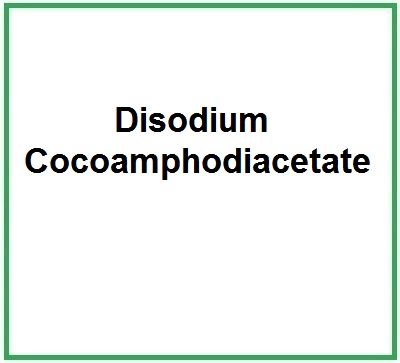Disodium Cocoamphodiacetate is a chemical compound and its chemical name is Disodium N-2-(N-(2-carboxymethoxyethyl)-N-carboxymethylamino)ethylcocamide.
It appears as an amber-yellow liquid.

What it is used for and where
Cosmetics
It is a surfactant obtained from coconut and is used in liquid soaps, shampoos and other when a delicate cleansing action is required. It acts as follows: cleaning agent, hair conditioning agent, skin conditioning agent, cleaning agent surfactant, foam booster surfactant, hydrotrope surfactant.
Cleaning agent. Ingredient that cleanses skin without exploiting the surface-active properties that produce a lowering of the surface tension of the stratum corneum.
Hair conditioning agent. A large number of ingredients with specific purposes can co-exist in a hair shampoo: cleansers, conditioners, thickeners, mattifying agents, sequestering agents, fragrances, preservatives, special additives. However, the indispensable ingredients are the cleansers and conditioners as they are necessary and sufficient for hair cleansing and manageability. The others act as commercial and non-essential auxiliaries such as: appearance, fragrance, colouring, etc. Hair conditioning agents have the task of increasing shine, manageability and volume, and reducing static electricity, especially after treatments such as colouring, ironing, waving, drying and brushing. They are, in practice, dispersing agents that may contain cationic surfactants, thickeners, emollients, polymers. The typology of hair conditioners includes: intensive conditioners, instant conditioners, thickening conditioners, drying conditioners.
Skin conditioning agent. An ingredient that is the mainstay of topical skin treatment by restoring, increasing or improving skin tolerance to external factors, including melanocyte tolerance. The most important function of the conditioning agent is to prevent skin dehydration, but the subject is rather complex and involves emollients and humectants.
Surfactant - Cleansing agent. Cosmetic products used to cleanse the skin utilise the surface-active action that produces a lowering of the surface tension of the stratum corneum, facilitating the removal of dirt and impurities.
Surfactant - Foam booster. It has the effect of introducing gas bubbles into the water and affects the cleaning process by helping to spread the cleanser. Since sebum has an inhibiting effect on the bubble, more foam is produced in the second shampoo.
Surfactant - Hydrotrope (solubilizing agents). It has the property of facilitating the miscibility of other compounds that are poorly soluble in water and does not form micelles in the solubilisation process, even with a chemical reaction of complexation or molecular aggregation. The two fundamental solubilisation factors are the hydrotropic-solute association mediated by the depression of water activity and ionic dissociation.
The most relevant studies on this chemical compound have been selected with a summary of their contents:
Disodium Cocoamphodiacetate studies
- Molecular Formula C18H35N2NaO4
- CAS 68650-39-5
- EC number 931-291-0
Synonyms :
- 2-Coconut alkyl-1-(2-hydroxyethyl)-2-imidazoline, reaction product with sodium chloroacetate
- Amphoteric 2
- Coconut fatty acid, aminoethylethanolamine imidazoline, dicarboxymethylated, disodium salt
- Imidazolium compounds, 1-(2-(carboxymethoxy)ethyl)-1-(carboxymethyl)-4,5-dihydro-2-norcoco alkyl, hydroxides, sodium salts
![]() Disodium Cocoamphodiacetate
Disodium Cocoamphodiacetate 


